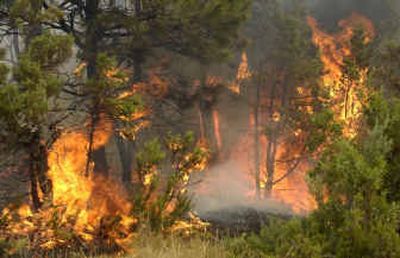Warning issued for fire season

BOISE – Federal wildfire forecasters say unusual rainfall patterns in the West this winter and spring have boosted growth of grasses and low-lying vegetation that will dry to fuel, setting the stage for a worse than normal fire season in the Southwest, Northern Rockies and Alaska.
“We are very concerned because we’ve had all the grass growth but the forests in the higher elevations of the Northwest and the Northern Rockies have missed out on all their snowpack,” Rick Ochoa, the national fire weather program manager for the National Weather Service, said Wednesday at a briefing with federal land agency fire managers. “Usually, when that snowpack gradually melts, you are basically watering the trees every day, but we’re missing that this year.”
While the Rocky Mountain region had a dry winter and wet spring, the precipitation pattern flip-flopped in the Southwest. A wetter-than-normal winter caused flooding and mudslides in Arizona, New Mexico, southern Nevada and Southern California, followed by a dry spring.
As a result, there are “wildflowers blooming in Death Valley and we’ve got grasses growing chest-high in places in the Southwest where we’ve never seen grasses before,” Ochoa said. Because of the dry spring in the Southwest, much of that vegetation has already dried or “cured,” dramatically boosting fire potential this summer.
Forecasters at the National Interagency Fire Center here don’t expect a repeat of last year’s record-setting fire season in Alaska, when nearly 6.4 million acres were scorched. But Ochoa said they anticipate higher-than-normal fire activity in the western Kenai Peninsula, where stands of spruce killed by insects have created a significant fire potential.
Alaska’s summer is expected to be warmer than normal, while the fire season in the Northern Rockies could be marked by a wetter-than-average summer. That doesn’t translate into a slow fire season, said Boise National Forest fire and aviation officer Guy Pence.
“The worst fire seasons I’ve experienced have been during the wettest years, because you always have storms pushing through,” he said. “Storms usually mean lightning and that’s where we get the ignition for most of our fires in this region.”
Because of the wet spring in the Northern Rockies and Pacific Northwest – more rain fell in Portland during April than in January and February combined – the fire season may be slower to start in those regions this season.
Still, with the warming trend experienced across much of the interior West recently, “it will be just a matter of weeks before these grasses dry out and are ready to burn,” Ochoa said.
Excluding Alaska, last year was a relatively mild fire season in the West, burning 1.4 million acres, according to the Interior Department. That compares to the 7.2 million acres consumed in the 2002 fire season, the worst in the last half-century.